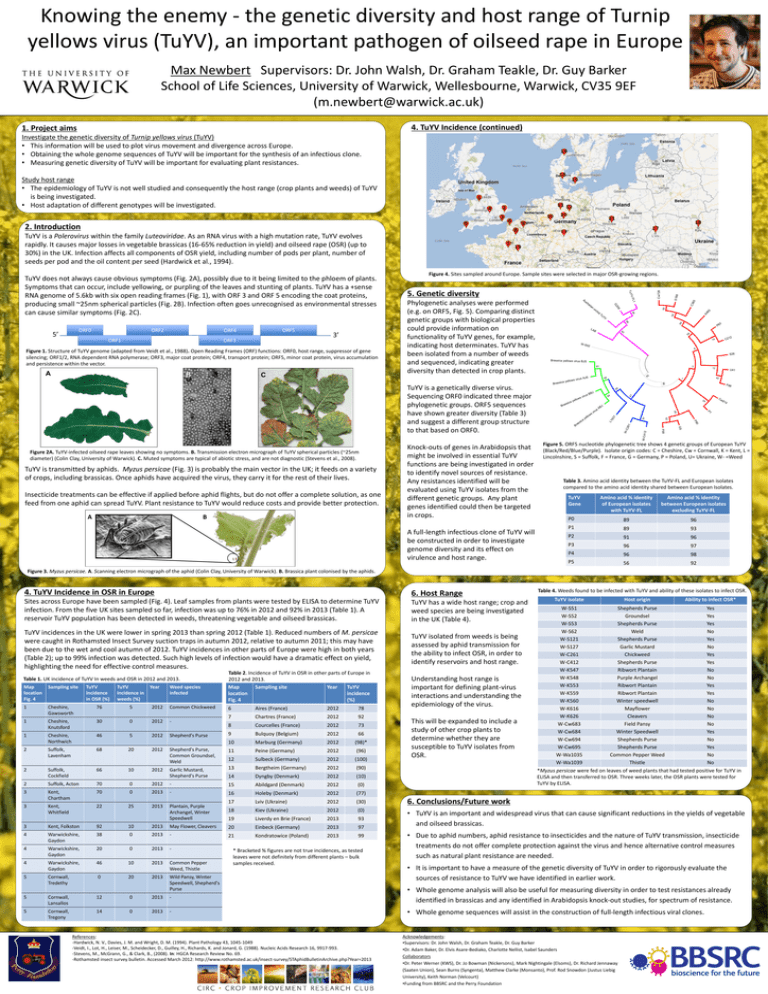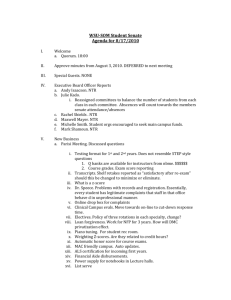Knowing the enemy - the genetic diversity and host range... yellows virus (TuYV), an important pathogen of oilseed rape in...
advertisement

Knowing the enemy - the genetic diversity and host range of Turnip yellows virus (TuYV), an important pathogen of oilseed rape in Europe Max Newbert Supervisors: Dr. John Walsh, Dr. Graham Teakle, Dr. Guy Barker School of Life Sciences, University of Warwick, Wellesbourne, Warwick, CV35 9EF (m.newbert@warwick.ac.uk) 4. TuYV Incidence (continued) 1. Project aims Investigate the genetic diversity of Turnip yellows virus (TuYV) • This information will be used to plot virus movement and divergence across Europe. • Obtaining the whole genome sequences of TuYV will be important for the synthesis of an infectious clone. • Measuring genetic diversity of TuYV will be important for evaluating plant resistances. Study host range • The epidemiology of TuYV is not well studied and consequently the host range (crop plants and weeds) of TuYV is being investigated. • Host adaptation of different genotypes will be investigated. 2. Introduction TuYV is a Polerovirus within the family Luteoviridae. As an RNA virus with a high mutation rate, TuYV evolves rapidly. It causes major losses in vegetable brassicas (16-65% reduction in yield) and oilseed rape (OSR) (up to 30%) in the UK. Infection affects all components of OSR yield, including number of pods per plant, number of seeds per pod and the oil content per seed (Hardwick et al., 1994). C3 65 S188 Cw728 54 K4 65 50 69 52 8 S26 Brassica yellows virus BJS 3 81 B ay rassic A JS virus ellows 62 99 12 U41 42 1 F9 8 99 AB 47 81 4 J 97 s ow l l ye us vir 2 ica Cw 24 W -C4 1 s as Br 94 61 s J BB C2 s B ra a sic lo w yel s v ir u P1 A full-length infectious clone of TuYV will be constructed in order to investigate genome diversity and its effect on virulence and host range. W-S 2 0 P9 B C2 1 74 G5 A 0 59 49 Insecticide treatments can be effective if applied before aphid flights, but do not offer a complete solution, as one feed from one aphid can spread TuYV. Plant resistance to TuYV would reduce costs and provide better protection. 62 F58 TuYV is transmitted by aphids. Myzus persicae (Fig. 3) is probably the main vector in the UK; it feeds on a variety of crops, including brassicas. Once aphids have acquired the virus, they carry it for the rest of their lives. LA B P6 52 Figure 2A. TuYV-infected oilseed rape leaves showing no symptoms. B. Transmission electron micrograph of TuYV spherical particles (~25nm diameter) (Colin Clay, University of Warwick). C. Muted symptoms are typical of abiotic stress, and are not diagnostic (Stevens et al., 2008). Knock-outs of genes in Arabidopsis that might be involved in essential TuYV functions are being investigated in order to identify novel sources of resistance. Any resistances identified will be evaluated using TuYV isolates from the different genetic groups. Any plant genes identified could then be targeted in crops. V 99 TuYV is a genetically diverse virus. Sequencing ORF0 indicated three major phylogenetic groups. ORF5 sequences have shown greater diversity (Table 3) and suggest a different group structure to that based on ORF0. Tu Y W- C hi d 7 B or c L1 93 A ia n 99 Figure 1. Structure of TuYV genome (adapted from Veidt et al., 1988). Open Reading Frames (ORF) functions: ORF0, host range, suppressor of gene silencing; ORF1/2, RNA dependent RNA polymerase; ORF3, major coat protein; ORF4, transport protein; ORF5, minor coat protein, virus accumulation and persistence within the vector. L1 ORF3 V -F ORF1 3’ st ra l 99 ORF5 ORF4 T uY 5’ ORF2 Phylogenetic analyses were performed (e.g. on ORF5, Fig. 5). Comparing distinct genetic groups with biological properties could provide information on functionality of TuYV genes, for example, indicating host determinates. TuYV has been isolated from a number of weeds and sequenced, indicating greater diversity than detected in crop plants. Au 09 ORF0 5. Genetic diversity G2 TuYV does not always cause obvious symptoms (Fig. 2A), possibly due to it being limited to the phloem of plants. Symptoms that can occur, include yellowing, or purpling of the leaves and stunting of plants. TuYV has a +sense RNA genome of 5.6kb with six open reading frames (Fig. 1), with ORF 3 and ORF 5 encoding the coat proteins, producing small ~25nm spherical particles (Fig. 2B). Infection often goes unrecognised as environmental stresses can cause similar symptoms (Fig. 2C). Figure 4. Sites sampled around Europe. Sample sites were selected in major OSR-growing regions. Figure 5. ORF5 nucleotide phylogenetic tree shows 4 genetic groups of European TuYV (Black/Red/Blue/Purple). Isolate origin codes: C = Cheshire, Cw = Cornwall, K = Kent, L = Lincolnshire, S = Suffolk, F = France, G = Germany, P = Poland, U= Ukraine, W- =Weed Table 3. Amino acid identity between the TuYV-FL and European isolates compared to the amino acid identity shared between European Isolates. TuYV Gene Amino acid % identity of European isolates with TuYV-FL Amino acid % identity between European isolates excluding TuYV-FL P0 89 96 P1 89 93 P2 91 96 P3 96 97 P4 96 98 P5 56 92 Figure 3. Myzus persicae. A. Scanning electron micrograph of the aphid (Colin Clay, University of Warwick). B. Brassica plant colonised by the aphids. 4. TuYV Incidence in OSR in Europe 6. Host Range Sites across Europe have been sampled (Fig. 4). Leaf samples from plants were tested by ELISA to determine TuYV infection. From the five UK sites sampled so far, infection was up to 76% in 2012 and 92% in 2013 (Table 1). A reservoir TuYV population has been detected in weeds, threatening vegetable and oilseed brassicas. TuYV has a wide host range; crop and weed species are being investigated in the UK (Table 4). TuYV incidences in the UK were lower in spring 2013 than spring 2012 (Table 1). Reduced numbers of M. persicae were caught in Rothamsted Insect Survey suction traps in autumn 2012, relative to autumn 2011; this may have been due to the wet and cool autumn of 2012. TuYV incidences in other parts of Europe were high in both years (Table 2); up to 99% infection was detected. Such high levels of infection would have a dramatic effect on yield, highlighting the need for effective control measures. TuYV isolated from weeds is being assessed by aphid transmission for the ability to infect OSR, in order to identify reservoirs and host range. Table 1. UK incidence of TuYV In weeds and OSR in 2012 and 2013. Map location Fig. 4 Sampling site 1 Cheshire, Gawsworth 76 5 2012 Common Chickweed 1 Cheshire, Knutsford 30 0 2012 - 1 Cheshire, Northwich 46 5 2012 Shepherd's Purse Suffolk, Lavenham 68 Suffolk, Cockfield 66 2 Suffolk, Acton 70 0 3 Kent, Chartham 70 3 Kent, Whitfield 22 2 2 TuYV incidence in OSR (%) TuYV Year incidence in weeds (%) Weed species infected Table 2. Incidence of TuYV in OSR in other parts of Europe in 2012 and 2013. Map Sampling site Year TuYV location incidence Fig. 4 (%) Understanding host range is important for defining plant-virus interactions and understanding the epidemiology of the virus. Table 4. Weeds found to be infected with TuYV and ability of these isolates to infect OSR. TuYV isolate Host origin Ability to infect OSR* W-S51 W-S52 W-S53 W-S62 W-S121 W-S127 W-C261 W-C412 W-K547 W-K548 W-K553 W-K559 W-K560 W-K616 W-K626 W-Cw683 W-Cw684 W-Cw694 W-Cw695 W-Wa1035 W-Wa1039 Shepherds Purse Groundsel Shepherds Purse Weld Shepherds Purse Garlic Mustard Chickweed Shepherds Purse Ribwort Plantain Purple Archangel Ribwort Plantain Ribwort Plantain Winter speedwell Mayflower Cleavers Field Pansy Winter Speedwell Shepherds Purse Shepherds Purse Common Pepper Weed Thistle Yes Yes Yes No Yes No Yes Yes No No Yes Yes No No No No Yes No Yes No No 6 Aires (France) 2012 78 7 Chartres (France) 2012 92 8 Courcelles (France) 2012 73 9 Bulquoy (Belgium) 2012 66 10 Marburg (Germany) 2012 (98)* Shepherd's Purse, Common Groundsel, Weld 11 Peine (Germany) 2012 (96) 12 Sulbeck (Germany) 2012 (100) Garlic Mustard, Shepherd's Purse 13 Bergtheim (Germany) 2012 (90) 14 Dyngby (Denmark) 2012 (10) 2012 - 15 Abildgard (Denmark) 2012 (0) 0 2013 - 16 Holeby (Denmark) 2012 (77) 25 2013 Plantain, Purple Archangel, Winter Speedwell 17 Lviv (Ukraine) 2012 (30) 6. Conclusions/Future work 18 Kiev (Ukraine) 2012 (0) 19 Liverdy en Brie (France) 2013 93 • TuYV is an important and widespread virus that can cause significant reductions in the yields of vegetable and oilseed brassicas. 20 10 2012 2012 3 Kent, Folkston 92 10 2013 May Flower, Cleavers 20 Einbeck (Germany) 2013 97 4 Warwickshire, Gaydon 38 0 2013 - 21 Kondratowice (Poland) 2013 99 4 Warwickshire, Gaydon 20 0 2013 - 4 Warwickshire, Gaydon 46 10 2013 Common Pepper Weed, Thistle 5 Cornwall, Tredethy 0 20 2013 Wild Pansy, Winter Speedwell, Shepherd's Purse 5 Cornwall, Lansallos 12 0 2013 - 5 Cornwall, Tregony 14 0 2013 - * Bracketed % figures are not true incidences, as tested leaves were not definitely from different plants – bulk samples received. References: -Hardwick, N. V., Davies, J. M. and Wright, D. M. (1994). Plant Pathology 43, 1045-1049 -Veidt, I., Lot, H., Leiser, M., Scheidecker, D., Guilley, H., Richards, K. and Jonard, G. (1988). Nucleic Acids Research 16, 9917-993. -Stevens, M., McGrann, G., & Clark, B., (2008). In: HGCA Research Review No. 69. -Rothamsted insect survey bulletin. Accessed March 2012: http://www.rothamsted.ac.uk/insect-survey/STAphidBulletinArchive.php?Year=2013 This will be expanded to include a study of other crop plants to determine whether they are susceptible to TuYV isolates from OSR. *Myzus persicae were fed on leaves of weed plants that had tested positive for TuYV in ELISA and then transferred to OSR. Three weeks later, the OSR plants were tested for TuYV by ELISA. • Due to aphid numbers, aphid resistance to insecticides and the nature of TuYV transmission, insecticide treatments do not offer complete protection against the virus and hence alternative control measures such as natural plant resistance are needed. • It is important to have a measure of the genetic diversity of TuYV in order to rigorously evaluate the sources of resistance to TuYV we have identified in earlier work. • Whole genome analysis will also be useful for measuring diversity in order to test resistances already identified in brassicas and any identified in Arabidopsis knock-out studies, for spectrum of resistance. • Whole genome sequences will assist in the construction of full-length infectious viral clones. Acknowledgements: •Supervisors: Dr. John Walsh, Dr. Graham Teakle, Dr. Guy Barker •Dr. Adam Baker, Dr. Elvis Asare-Bediako, Charlotte Nellist, Isabel Saunders Collaborators •Dr. Peter Werner (KWS), Dr. Jo Bowman (Nickersons), Mark Nightingale (Elsoms), Dr. Richard Jennaway (Saaten Union), Sean Burns (Syngenta), Matthew Clarke (Monsanto), Prof. Rod Snowdon (Justus Liebig University), Keith Norman (Velcourt) •Funding from BBSRC and the Perry Foundation





